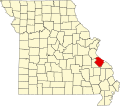Jacques Dubreuil Guibourd House | |
 Front and side of the house | |
| Location | Northwestern corner of 4th and Merchant Sts., Ste. Genevieve, Missouri |
|---|---|
| Coordinates | 37°58′48″N90°2′53″W / 37.98000°N 90.04806°W |
| Built | 1800 |
| Architectural style | French Colonial |
| Part of | Ste. Genevieve Historic District (ID66000892) |
| NRHP reference No. | 69000307 [1] |
| Significant dates | |
| Added to NRHP | May 21, 1969 |
| Designated NHLDCP | October 9, 1960 |
The Guibourd House, also known as La Maison de Guibourd, is an example of poteaux-sur-solle (vertical post on sill or foundation) sealed with bouzillage (usually a mixture of clay and grass) construction. The structure was built around 1806 and was the home of Jacques Jean Rene Guibourd and his family.
Contents
- Jacques Jean-René Guibourd de Luzinais
- From Candé to Sainte Genevieve
- Further reading
- See also
- References
- External links
The basic architecture of the Guibourd House is very similar to other Creole-French structures around the town and throughout the French inhabited regions of the Illinois Country/territory, eastern Canada and the Louisiana territory.
The structure's design has been changed only slightly over the years to accommodate the needs of the various residents, but overall retains much of the original character and style of the early 19th century French Creole architecture. The house had originally been built with 'galleries' (or wide porches) surrounding the house to keep the interior cool in the summer and the snow off in the winter.
The slave quarters or kitchen was added a few years later. The kitchen building was made of brick and detached from the main house due the added heat of cooking during the summer months, the smoke associated with cooking that would linger on cloth furnishings, and finally, because the French considered the smell of cooking to be offensive. (Contrary to the myth that kitchens were separate from the house due to the dangers of fire in the food preparation areas, extensive research has been done on the subject with no substantial facts to back it up. Refer to the book Death by Petticoat, by Mary Theobald, Colonial Williamsburg Press.) The Guibourd kitchen was built in a semi-attached fashion, under one corner of the porch. This proved invaluable for the family and slaves when serving meals to be able to keep them hot, dry and timely. The Guibourd House has one of the few original kitchen structures and slave quarters of this time period in Ste. Genevieve.
The woodwork found in Creole houses is similar to that of contemporaneous American houses, being fashioned probably by the same craftsmen. Glass was used early; the Guibourd house in Ste. Genevieve still has two pairs of casement windows similar to those found in Canada and Louisiana. Hardware and nails for Creole houses were imported at an early date, and three wrought-Iron door latches found in Ste. Genevieve show a close affinity to those of Quebec. The interior walls were often plastered and white-washed, and in more luxurious homes were sometimes frescoed or painted in panels, as in the Laclede-Chouteau house; but the ceilings were left open to show the carefully shaped beams (soUveaux), with their beaded moulding, and the attic flooring. Shrines and tall wooden crosses on inscribed stone pedestals added to the European appearance of the early settlements.
The immigration which began about the time of the American Revolution, and reached its full tide after the War of 1812, destroyed most of the Creole architectural traditions. Charles Dickens, visiting St. Louis in 1842, found that "In the old French portions of the town the thoroughfares are narrow and crooked, and some of the houses are quaint and picturesque, being built of wood, with tumble-down galleries ... and an abundance of crazy old tenements with blinking casements, such as may be seen in Flanders. Some of these ancient habitations, with high garret gable windows perking into the roofs, have a kind of French shrug about them; and being lopsided with age, appear to hold their heads askew, as if they were grimacing in astonishment at the American improvements ..." But seven years after Dickens' visit, much of the French section was destroyed by fire, and two generations ago, the last house of the French type in St. Louis was pulled down.
— A Guide to the "Show Me" State, 1941 [2]
The Guibourd House is a contributing property in the Ste. Genevieve Historic District, which is a National Historic Landmark. The house is operated as a historic house museum by the Foundation for Restoration of Ste. Genevieve, Inc.





